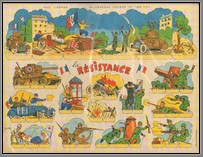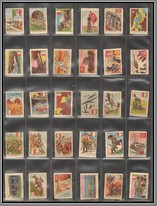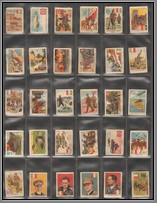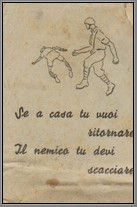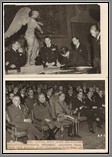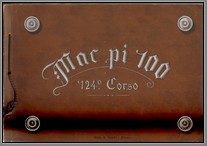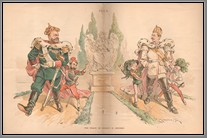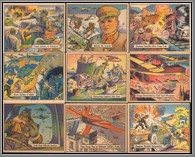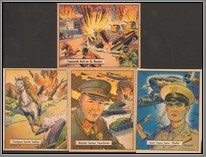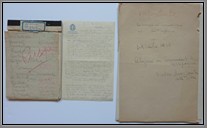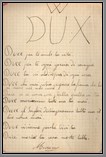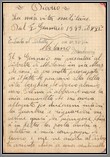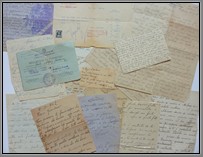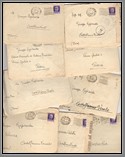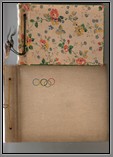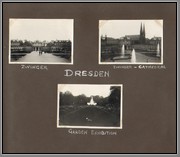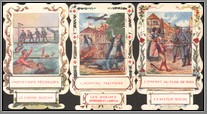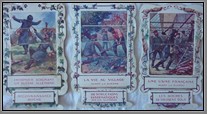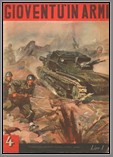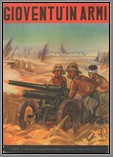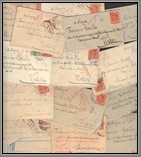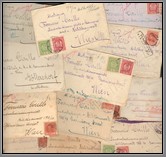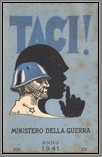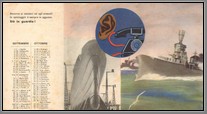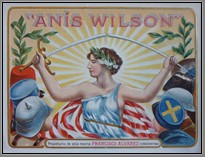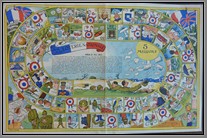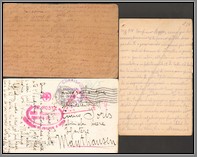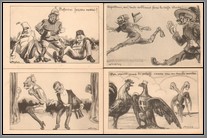World War 1 & 2
2 sets of Italian childrens confectionary cards produced during World War 2. The first set is complete with all 105 cards present. It glorifies Italy's performance during the war. The second set contains 102/105 cards and was produced during the war but before Italy joined the fight. It shows different military personnel from the countries engaged in the war, and their colonies, as well as the different instruments of war for both Italy and the UK. What is interesting is that the one collection was produced during the war but before Italy's involvement and the other collection reflects Italy's involvement. Rare and almost impossible to complete. M
Price: $2400.00
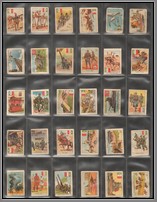 WW 303 WW 303 | 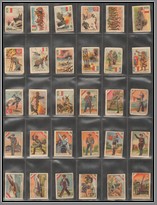 WW 303 WW 303 | 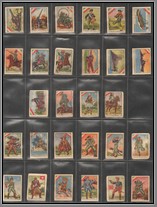 WW 303 WW 303 | 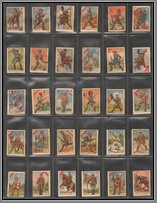 WW 303 WW 303 | 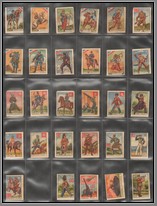 WW 303 WW 303 |
Rare Italian flipbook, with the translated title “if at home you wanted to retard the enemy you must drive away”. It shows an Italian soldier kicking away a British soldier ready to throw a bomb. He dies when the Italian kicks him away and the bomb explodes. The soldier then runs home to his wife who is anxiously waiting with open arms. Complete. M
Price: $900.00
Two press photos of Japanese-Italian relations during World War 2. One shows the signing of the economic cooperation agreement between Italy and Japan on January 1, 1943. The other is the inauguration of the new building for the Japanese Friendship Society on February 11, 1942. Both photos captioned in Italian. m
Price: $80.00
The 1942-1943 celebration of Mac Pi 100. This is an initiation ceremony for graduates in the Italian military. This was the last ceremony celebrated while Italy was under fascist rule. The book is divided into 8 different sections of military training. M
Price: $500.00
Note: from Wikipedia: The origin of the Mak P tradition is purely military: the ceremony was born in 1840 at the Military Academy of Turin . In that year a royal decree fixed the duration of the courses in three years to obtain the appointment as second lieutenant and in learning this arrangement a pupil, Emanuele Balbo Bertone di Sambuy, exclaimed in Piedmontese : " Mach pi tre tre ani! », Literally« Only more than three years! »(That is still only three years).
The expression became popular; the years were then converted into days and the students took the habit of counting up to climb, writing the days that were lacking in the promotion even on blackboards. Mak P became the typical expression, 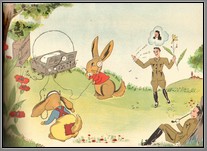 WW 294repeated from year to year, at the approach of the conclusion of the training course of the officers.
WW 294repeated from year to year, at the approach of the conclusion of the training course of the officers.
In 1891 the custom moved from Turin to the rest of the military schools, transforming itself into a real institutional recurrence, whose main event is the "Passaggio della Stecca" (a wooden tool formerly used to polish the buttons the uniform without making it dirty) between the head of the "elders" and the head of the "cappelloni", the first year students. Today it is a widespread tradition almost all over the country.
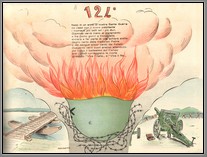 WW 294 WW 294 | 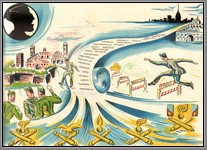 WW 294 WW 294 | 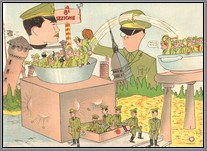 WW 294 WW 294 |
Military files belonging to GOLD MEDAL recipient Alessandro Gorini. He was born in Torino in 1890 and died in 1977(?) in Milan. He was decorated in World War 1 where he lost an eye, was an officer with the Black Shirts and commanded the 220th Legion in the Tevere Devision (where he was also Service Director of the Division) in Africa in 1936. He fought in Russia and during the Social Republic period he helped the partisans and for this he received the GOLD MEDAL, Italy’s highest military honor. There is one file marked IMPORTANTE, and it is correspondence to and from him within the military in Somalia in 1936. The interesting thing is that the Tevere Division (which included the 219th, 220th, 221st and 320th Legion) 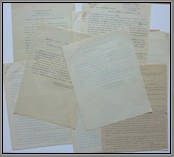 WW 289was a Division consisting of Italian volunteers from abroad and amputees, veterans and former volunteers arditi of the Great War. It was the last of the 6 Black Shirt Divisions Mussolini raised to fight in Ethiopia in 1935. Due to age (World War I veterans), physical disabilities (amputated veterans), lack of military training (Italians living abroad) and lack of supporting machine guns and pack artillery the Division was of limited combat value. Nevertheless, it saw some combat in minor actions on the Somali front, and performed well under the command of Gen. Enrico Boscardi. The motto of the division was "Molti nemici, molto onore" (Many enemies, much honor). The Division was raised in 1935 before the war and disbanded in 1936. The file includes 17 manuscript documents from his officers to him in his capacity as the Service Director of the Division. Interesting information on strengths of the “Mutilated Battalions”. It is important to note that of the 11 battalions in the Tevere Division, the only World War 1 Amputee Battalion was part of Gorini’s 220th Legion. The documents range from one page to 6 pages. This is the only example of correspondence from the Tevere Division I have seen as it only existed for less than two years. The second item is what appears to be Gorini’s diary of his time in Russia. It is 68 pages. Lastly, there is an 8 page manuscript biography of Gorini from an unknown source. It is in draft form and tracks his career from the 1911-1912 war in Libya, fighting Austria from 1915-1918, fighting in Ethiopia from 1935-1936. It confirms his time on the Russian Front and his imprisonmnent by the fascists in late 1944. He then fought with the partisans. M
WW 289was a Division consisting of Italian volunteers from abroad and amputees, veterans and former volunteers arditi of the Great War. It was the last of the 6 Black Shirt Divisions Mussolini raised to fight in Ethiopia in 1935. Due to age (World War I veterans), physical disabilities (amputated veterans), lack of military training (Italians living abroad) and lack of supporting machine guns and pack artillery the Division was of limited combat value. Nevertheless, it saw some combat in minor actions on the Somali front, and performed well under the command of Gen. Enrico Boscardi. The motto of the division was "Molti nemici, molto onore" (Many enemies, much honor). The Division was raised in 1935 before the war and disbanded in 1936. The file includes 17 manuscript documents from his officers to him in his capacity as the Service Director of the Division. Interesting information on strengths of the “Mutilated Battalions”. It is important to note that of the 11 battalions in the Tevere Division, the only World War 1 Amputee Battalion was part of Gorini’s 220th Legion. The documents range from one page to 6 pages. This is the only example of correspondence from the Tevere Division I have seen as it only existed for less than two years. The second item is what appears to be Gorini’s diary of his time in Russia. It is 68 pages. Lastly, there is an 8 page manuscript biography of Gorini from an unknown source. It is in draft form and tracks his career from the 1911-1912 war in Libya, fighting Austria from 1915-1918, fighting in Ethiopia from 1935-1936. It confirms his time on the Russian Front and his imprisonmnent by the fascists in late 1944. He then fought with the partisans. M
Price: $1000.00
Rare diary kept by an Italian soldier name Sereno Mirin with the 7th Corpo d’Armata Regg. Ticchioni. He fought in Corsica and Sardinia. The diary dates from January 1943 to April 1944, a few months before his unit was disbanded. 75 pages. This is the only manuscript I have ever seen of the Italian occupation of Cosrica. Places in Corsica and Sardinia mentioned include Aiaccio, Suartello, Iglesias, Perfuga Lar Deyna and Bulzi. Diary begins with his preparation in Milan. Diary contains more material on Sardinia than Corsica. Boards separated, loose pages. M
Price: $700.00
Note: From Wikipedia: On 8 November 1942, the Allies landed in North Africa. In response, Nazi Germany formulated Operation Anton, as part of which Italy occupied the island of Corsica on November 11 (Italian operation codename: "Operazione C2"), and some parts of France up to the Rhone. The occupation force initially included 30,000 Italian troops and gradually reached the size of nearly 85,000 soldiers. This was a huge occupation force relative to the size of the local population of 220,000.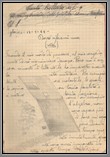 WW 288
WW 288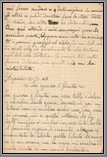 WW 288 The VII Army Corps of the Regio Esercito was able to occupy Corsica, which was still under the formal sovereignty of Vichy France, without a fight. Because of the initial lack of perceived partisan resistance and to avoid problems with Marshal Philippe Pétain, no Corsican units were formed under Italian control (except for a labour battalion in March 1943). The Corsican population initially showed some support for the Italians, partly as a consequence of irredentist propaganda. The Italian troops grew to encompass two Army Divisions (the "Friuli" and the "Cremona"), two coastal Divisions (the Italian 225 Coastal Division and the Italian 226 Coastal Division), eight battalions of Fascist Militia, and some units of Military Police and Carabinieri. The Italian troops were commanded by General Mondino until the end of December 1942, then by General Carboni until March 1943 and later by General Magli until September 1943.
WW 288 The VII Army Corps of the Regio Esercito was able to occupy Corsica, which was still under the formal sovereignty of Vichy France, without a fight. Because of the initial lack of perceived partisan resistance and to avoid problems with Marshal Philippe Pétain, no Corsican units were formed under Italian control (except for a labour battalion in March 1943). The Corsican population initially showed some support for the Italians, partly as a consequence of irredentist propaganda. The Italian troops grew to encompass two Army Divisions (the "Friuli" and the "Cremona"), two coastal Divisions (the Italian 225 Coastal Division and the Italian 226 Coastal Division), eight battalions of Fascist Militia, and some units of Military Police and Carabinieri. The Italian troops were commanded by General Mondino until the end of December 1942, then by General Carboni until March 1943 and later by General Magli until September 1943.
In Corsica, the native collaborationists linked to the Italian irredentist movement supported the Italian occupation, stressing that this was a precautionary measure against a possible Anglo-American attack. Also some Corsican military officers collaborated with Italy, including the retired Major Pantalacci (and his son Antonio), Colonel Mondielli and Colonel Simon Petru Cristofini (and his wife, the first Corsican female journalist Marta Renucci). Cristofini, who even met Benito Mussolini in Rome, was a strong supporter of the union of Corsica with Italy and defended irredentist ideals.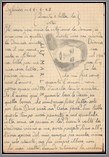 WW 288
WW 288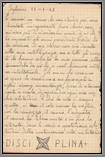 WW 288 Indeed, Cristofini actively collaborated with the Italian forces in Corsica during the first months of 1943 and (as head of the Ajaccio troops) helped the Italian Army to repress the Resistance in Corsica before the Italian Armistice in September 1943. He closely worked with the famous Corsican writer Petru Giovacchini, who was named as the potential "Governor of Corsica" had the Kingdom of Italy annexed the island. In the first months of 1943 these irredentists, under the leadership of Petru Giovacchini and Bertino Poli, conducted large-scale propaganda efforts among the Corsican population to promote the unification of Corsica to Italy, as had been done in 1941 with Dalmatia (where Mussolini created the Governatorate of Dalmatia). Indeed, there was a mild support of the Italian occupation from most of the Corsican population until summer 1943. The Italian occupation of Corsica was related to the Nazi Germany dominion of Europe over which Adolf Hitler ultimately exercised control: Benito Mussolini thus postponed the unification of Corsica to Italy until a "Peace Treaty" could be done after the hypothetical Axis victory in World War II, mainly because of German opposition to the irredentist claims. Social and economic life in Corsica was administered by the original French civil authorities. On November 14, 1943, the prefet restated French sovereignty over the island and stated that the Italian troops were occupiers. The French Resistance was initially limited, but it started taking shape immediately in the aftermath of the Italian invasion.
WW 288 Indeed, Cristofini actively collaborated with the Italian forces in Corsica during the first months of 1943 and (as head of the Ajaccio troops) helped the Italian Army to repress the Resistance in Corsica before the Italian Armistice in September 1943. He closely worked with the famous Corsican writer Petru Giovacchini, who was named as the potential "Governor of Corsica" had the Kingdom of Italy annexed the island. In the first months of 1943 these irredentists, under the leadership of Petru Giovacchini and Bertino Poli, conducted large-scale propaganda efforts among the Corsican population to promote the unification of Corsica to Italy, as had been done in 1941 with Dalmatia (where Mussolini created the Governatorate of Dalmatia). Indeed, there was a mild support of the Italian occupation from most of the Corsican population until summer 1943. The Italian occupation of Corsica was related to the Nazi Germany dominion of Europe over which Adolf Hitler ultimately exercised control: Benito Mussolini thus postponed the unification of Corsica to Italy until a "Peace Treaty" could be done after the hypothetical Axis victory in World War II, mainly because of German opposition to the irredentist claims. Social and economic life in Corsica was administered by the original French civil authorities. On November 14, 1943, the prefet restated French sovereignty over the island and stated that the Italian troops were occupiers. The French Resistance was initially limited, but it started taking shape immediately in the aftermath of the Italian invasion.
Following the imprisonment of Benito Mussolini in July 1943, 12,000 German troops came to Corsica. They formally took over the occupation on 9 September 1943, the day after the armistice between Italy and the Allies. While their leaders were ambivalent, most of the Italian troops remained loyal to the Italian King Victor Emmanuel III and some fought (mainly at Teghime, Bastia, and Casamozza) alongside the French Resistance against the German troops until the liberation of Corsica on 4 October 1943. Meanwhile, the Resistance aimed to establish control of the mountains in the island's center, to prevent the occupying forces from moving from one coast to the other and thus facilitating an Allied invasion.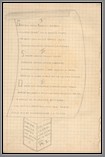 WW 288
WW 288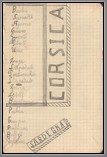 WW 288
WW 288
The liberation of Corsica began with an uprising ordered by the local Resistance on 9 September 1943. The Allies did not initially want such a movement, preferring to focus their forces on the invasion of Italy. However, in light of the insurrection, the Allies acquiesced to Free French troops landing on Corsica, starting with an elite detachment of the reconstituted French I Corps landing ( by the submarine Casabianca) at Arone near the village of Piana in northwest Corsica. This prompted the German troops to attack Italian troops in Corsica as well as the Resistance. The Resistance, and the Italian 44 Infantry Division Cremona and 20 Infantry Division Friuli engaged in heavy combat with the German Sturmbrigade Reichsführer SS. The Sturmbrigade was joined by the 90th Panzergrenadier Division and the Italian 12th Parachute Battalion of the 184th Parachute Regiment, which were retreating from Sardinia through Corsica, from Bonifacio to the northern port of Bastia. There were now 30,000 German troops in Corsica withdrawing via Bastia. On 13 September elements of the 4th Moroccan Mountain Division landed in Ajaccio to try to stop the Germans. During the night of 3 to 4 October the last German units evacuated Bastia, leaving behind 700 dead and 350 POWs.
Collection of letters and correspondence to a soldier name Giordano Negri, between 1939-1942. He may have been affiliated with the San Marco Brigade in China as there are several letters relating to this from the Italian Embassy guard in Peking. Over 50 different items, including his order to mobilize from the fascist party, letters from his brother Enrico who was a famous marble sculptor. B
Price: $300.00
9 letters with covers from Giorgio Baggio in Torino to Giuseppe Rapisarda in Castelfranco Veneto between 1940-1942. What is remarkable is the artwork, showing images of the day, models, Italian life. One of the drawings contains information written backwards, as though the artist were facing a storefront window from the interior. M
Price: $700.00
Two German photo albums from 1936. The first is mainly from Dresden, but other smaller cities as well. Shows life in a city all but destroyed in 1945. 146 photos in all, some with captions and dates. The second is in a nice Olympics commemorative album (but no pics of the Olympics). Shows Cologne, Hanover, Berlin, Potsdam, Dresden, Prague, Munich, Nuremberg, Budapest, Vienna. 81 photos in all. Nicely captioned. A good cross section of Germany and East Europe pre-war. m
Price: $300.00
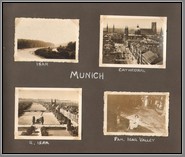 WW 283 WW 283 | 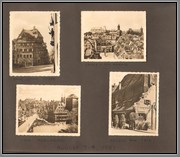 WW 283 WW 283 | 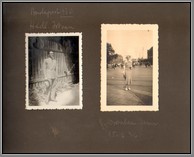 WW 283 WW 283 | 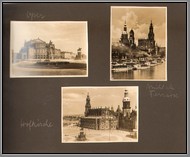 WW 283 WW 283 |
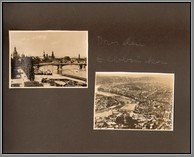 WW 283 WW 283 | 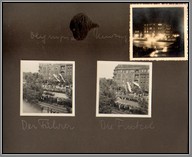 WW 283 WW 283 | 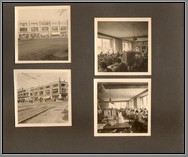 WW 283 WW 283 | 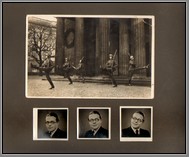 WW 283 WW 283 |
Collection of 37 letters (in original envelopes) to a soldier of Italian descent from Trieste, fighting with the Austro-Hungarian Empire. His name was Ferruccio Cirillo. The letters are from his father and what appears to be his sweetheart. He is based in Vienna. They all date from 1918. What makes this collection interesting is that Trieste became part of Italy after World War 1 and here we have an Italian fighting for Austria-Hungary. m
Price: $450.00

